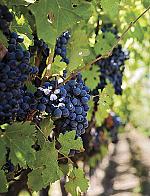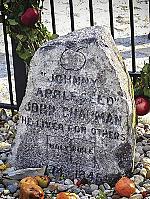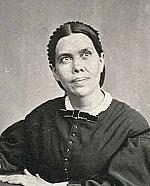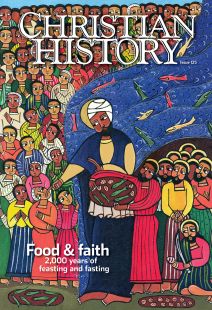Everyday substances, heavenly gifts

The Christian Lord’s Supper—Mass, Eucharist, or Holy Communion—typically centers on sharing bread and wine. In the modern Western culinary imagination, these may seem to be just an accompaniment and a luxurious or pleasant beverage, not a meal on their own. And the thin wafer and sip of grape juice used in many contemporary churches bear little resemblance to our regular food.
Yet for a couple of centuries, the Christian meal—most commonly called “Eucharist” at its earliest cele-brations—was both a sacred event and a means to use ordinary food to satisfy hunger.
making a meal
Bread and wine were central to the diet of the ancient Mediterranean world. Bread was the staple food for most people—the heart of a typical meal, not just a side dish. Wine also was an effective means of storing and sharing the food value of the important grape crop and not just a luxury for festive occasions. Bread and wine together made a meal, or most of it.
Ancient Christians used both leavened and unleavened bread. While the synoptic Gospels (Matthew, Mark, and Luke) identify Jesus’s fateful meal as a Passover meal, none of them specify the bread as being unleavened, though it likely was. Many poorer people in the ancient Mediterranean world, not just Jews at Passover, ate their bread unleavened, since leavening required the luxury of time for the bread to rise.
Early Christians preferred leavened bread, however, and probably leavened the bread of the Eucharist whenever possible. Only in the Middle Ages did the Western church develop (or regain) a stronger sense of the connection between the Eucharist and Passover, which led to a formal requirement for unleavened bread. And although the poor also ate bread made of barley or other grains when necessary, wheat bread seems to have been the norm.
God’s banquet
The presence of the poor and hungry played an important role in the formation and growth of the early church.While arguments about meat-eating consumed some of St Paul’s privileged readers in Corinth (1 Cor. 8 and 10), the less wealthy in the same community apparently missed out even on bread when arriving late or empty-handed to the Christian “banquet,” a word that implies abundance (1 Cor. 11).
Paul famously criticized this inequality (1 Cor. 11:17–34) and offered the oldest version we have of the famous story of Jesus breaking bread and sharing the cup—not as a handbook for ritual but as a moral example for sharing equally and in humility:
When you come together, it is not really to eat the Lord’s supper. For when the time comes to eat, each of you goes ahead with your own supper, and one goes hungry and another becomes drunk. What! Do you not have homes to eat and drink in? . . .
For I received from the Lord what I also handed on to you, that the Lord Jesus on the night when he was betrayed took a loaf of bread, and when he had given thanks, he broke it and said, “This is my body that is for you. Do this in remembrance of me.”
In the same way he took the cup also, after supper, saying, “This cup is the new covenant in my blood. Do this, as often as you drink it, in remembrance of me.” For as often as you eat this bread and drink the cup, you proclaim the Lord’s death until he comes (1 Cor. 11:20–26, NRSV).
There is no reason to think the “banquet” stopped being substantial after Paul wrote his letter. For many people in the ancient world, as in the modern, access even to ordinary food like bread could not be taken for granted from day to day. Rome had a grain dole for its citizens, but this only applied to the males of old local families, not to the many foreign workers, whose labor kept the city running.
Whatever else it was, the Eucharist was an inclusive feeding program. The simplicity of this Eucharistic food and drink was important relative to elite Roman banquets with their multiple courses; real hunger was satisfied, but this was not a feast for the sophisticated palate.
As late as 200, the North African teacher Tertullian still described “God’s banquet” in worship at Carthage as a literal, if modest, meal in Chapter 39 of his Apology:
We do not recline until we have first tasted of prayer to God; as much is eaten as to satisfy the hungry; only as much is drunk as is proper to the chaste. They are satisfied as people who remember that they have to praise God even in the night; they talk as people who know that the Lord is listening. After water for washing the hands, and lighting lamps, each is invited to sing publicly to God as able, from holy Scripture or from their own ability; thus how much each has drunk is put to the test. Similarly, prayer closes the feast.
Wine and water
Wine was important at any ancient banquet, sacred or not. Typically the sharing of cups or bowls of wine mixed with water followed the solid meal, as the Last Supper stories suggest. Although wine was certainly required for such festive occasions, even poor people drank it regularly.
Though the myth circulates that wine was the only safe drinking option, given the quality of ancient water supplies, inhabitants of premodern cities would not have known water carried disease. In any case they often had good water from aqueducts and wells. More important was the food value of wine—calories are often valuable to the poor and hungry—as well as its comforting effects on the drinker.
Yet some Christians rejected wine and either used water for the Eucharistic cup, or omitted a cup altogether from their meals. Some early Christian texts refer to the whole event just as the “breaking of bread” (see Luke 24:35; Acts 2:42); others specify water in the cup, or depict Eucharistic meals without mention of any beverage.
The reasons for avoiding wine were not those of modern teetotaling Christians (see “Raise a juice box to the temperance movement,” pp. 33–37). Instead, they reflect the central role of wine in pagan rituals. Formal Greek and Roman meals began with libations to the gods, a ritual of pouring wine onto the ground and then drinking the remainder from a wine jar or bowl, thought to sanctify the meal to those deities.
This strong association with paganism was enough to keep some Christians away from all wine. Other Christians and Jews substituted a cup of blessing or thanksgiving for the pagan libation. Juice, we should note, was not really an alternative; in a world without refrigeration or pasteurization, juice quickly became a different and milder sort of wine—but wine nevertheless.
So too the place of meat in Greco-Roman religion led to its avoidance altogether by some of the same Christian communities. Much of the meat available had been sacrificed to the gods first, as Paul indicated (1 Cor. 8). Avoiding wine and meat thus made sense to some (Rom. 14:21). These concerns reveal an anxiety about real or perceived collusion, via eating and drinking, with the demonic forces thought to be behind the gods of the Greeks and Romans.
Is it not a sharing in his blood?
Later tradition has focused very firmly on the meal as a representation of the death of Jesus, and famous arguments of the Reformation era centered on whether the meal was a sacrifice and, if so, how.
Despite the absence of meat from the Eucharist, the earliest Christians did see the meal in sacrificial terms. Paul used the sacrifices of the Jerusalem Temple and of local Greek temples to help explain how the Corinthian supper created a koinonia—a communion—for the participants:
The cup of blessing that we bless, is it not a sharing in the blood of Christ? The bread that we break, is it not a sharing in the body of Christ? . . . Consider the people of Israel; are not those who eat the sacrifices partners in the altar? What do I imply then? That food sacrificed to idols is anything, or that an idol is anything? No, I imply that what pagans sacrifice, they sacrifice to demons and not to God. I do not want you to be partners with demons. You cannot drink the cup of the Lord and the cup of demons. You cannot partake of the table of the Lord and the table of demons (1 Cor. 10:16–21, NRSV).
If it was going to be a sacrifice, the absence of meat made the Christian banquet a curious one, at least to Greeks. But it was rooted in Jewish tradition, well known to Christians; the offerings of the Old Testament involved meat, but also gave a significant place to grain and bread offerings (see Lev. 2), as well as to wine.
In fact, Scripture refers to Melchizedek, priest-king of Salem, bringing Abraham offerings of bread and wine (Gen. 14:18). These traditions offered Christians ways of thinking about a meal of bread and wine as being a sacrifice.
Christian sources written shortly after the New Testament—the Didache, Justin Martyr, and Irenaeus among them—present the meal as a sacrifice of bread and wine. They did see the food and drink as the body and blood of Christ, but Jesus could be present at the meal as host or participant (see Luke 24:28–35), not just as the main course.
The Eucharist was that “pure sacrifice” the prophet Malachi had foretold (1:11), one celebrated without the gore of pagan temples. Thanksgiving to God—as the name “Eucharist,” Greek for “giving thanks,” implies—was the clear emphasis.
pass the cheese
The typical Greek or Roman meal was understood to have three elements: the grain or bread staple (sitos), the side dishes (opsa), and the drink (potos). This structure worked just like “meat and two or three vegetables” does in many parts of the English-speaking world, and the absence of any one would have been curious.
Two of the three have obvious equivalents in the Eucharist; but did Christians have liturgical side dishes? Apparently, yes. The instructions for a festive Eucharist at the ordination of a third-century bishop include blessings for cheese and olives, somewhat like those for bread and wine.
Although by then the Eucharist seemed to be a token meal, the inclusion of these foods probably reflected recent memory of the meal as both sacred and substantial. Other narratives from the same period or earlier variously refer to oil, salt, cheese, and vegetables as shared at Christian community meals.
It is also possible that other foods were on the table at early Eucharistic gatherings without being mentioned. Meat never seems to have made it to the table, however; the imagery of bread and wine themselves as Jesus’s body and blood may have made meat symbolically inappropriate as well.
Fish could perhaps have been eaten, given the prominence of fish in Gospel traditions and in later Christian art. Fish was not tainted by association with pagan ritual the way meat was; domestic land animals were required in sacrifices, while fish as wild creatures were safer for Christians (and Jews) to eat. By the second century, the acrostic IXΘΥΣ —the Greek word for “fish,” made up of the initials of the phrase “Jesus Christ, Son of God, Savior”—was well known.
Despite this no evidence exists for actual fish at the Eucharist; it was apparently a good symbol, but better to draw or to think about than to eat.
From Meal to Sacrament
The ancient Eucharist thus presents us with the curiosity of a celebratory meal that was substantial in character, yet also modest both in quantity and in quality of foods. Bread and wine—and sometimes other foods too—were recognizable to the participants as everyday substances, but were received as heavenly gifts. Each Eucharist bridged heaven and earth, the glorious and the mundane.
In the third century, the sheer growth of the Christian community meant that banquets became less viable settings for gatherings of a local church.
At the same time, the significance of the blessed bread and wine as the body and blood of Christ was interpreted more and more concretely. Together, these developments allowed or required the shift from Eucharists as evening meals to morning gatherings, where Christians received the blessed food and drink, eating small amounts that only evoked a meal (see “From Cana to Jell-O,” pp. 41–43).
Even in their familiar token forms, bread and wine still reflect the symbolism not merely of the Last Supper, but of the ancient Mediterranean meal in general. Products of the earth and of human labor, they link those who eat and drink them with an ancient past and a heavenly future. CH
By Andrew McGowan
[Christian History originally published this article in Christian History Issue #125 in 2018]
Andrew McGowan is J. L. Caldwell McFaddin and Rosine B. McFaddin Professor of Anglican Studies and Pastoral Theology and dean of Berkeley Divinity School at Yale. He is the author of Ancient Christian Worship and Ascetic Eucharists.Next articles
Eating (and not eating) with the church fathers
Things church fathers said about food
Jennifer Woodruff Tait, compilerRaise a juice box to the temperance movement
Getting unfermented wine from the vineyard
Jennifer Woodruff TaitSupport us
Christian History Institute (CHI) is a non-profit Pennsylvania corporation founded in 1982. Your donations support the continuation of this ministry
Donate






